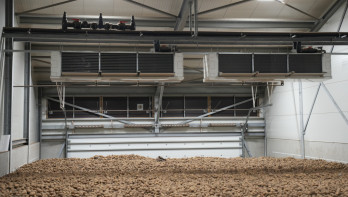Analysis Potatoes
NEPG: record potato harvest in EU-4
The European growers' organization NEPG expects an above-average consumption potato harvest in the EU-4 this year. A 7% larger area partially compensates for late planting dates, emergence problems, and extreme weather. Nevertheless, the organization anticipates a yield close to that of 2023.
During the recent Potato Europe event held in Northern France, the North-Western European Potato Growers (NEPG) estimated the upcoming potato harvest in Northwestern Europe. The extreme year 2024 follows the extreme year 2023, but this does not mean there is a shortage of potatoes.
The area in the EU-4 has increased by 7% to 560,000 hectares, according to NEPG's estimation. The organization has not yet provided country-specific figures. This season, it expects a yield per hectare similar to last year, amounting to 43.7 tons per hectare. Multiplying by the hectares, this results in a yield of nearly 24.5 million tons of potatoes, well above the 22.66 million tons harvested last year. This is 4.1% more than the previous record set in 2017 when 23.5 million tons were harvested.
80 different varieties planted for the fries industry
These figures are quite remarkable when looking back at the past nine months. A planting season that lasted ten weeks, poor structure, issues with seed potato quality, and a very high disease pressure, especially from phytophthora. To address the seed potato shortage, eighty different varieties were planted for the fries industry, particularly in Belgium, as reported by NEPG. Some batches, according to the organization, are not suitable for storage due to low specific gravity or baking quality, for example. On the other hand, blue discoloration - caused by excessively high specific gravity - or rot from bacteria or phytophthora can also be problematic.
On the other end of the chain, NEPG members also issue a warning. Processing capacity in Northwestern Europe may be growing faster than consumption. At the same time, production is also increasing in North America, Asia, and South America. Therefore, growers are urged to monitor demand and not overtake it. Both growers and buyers must also consider the climate issue. How can potatoes be grown as costs rise, withstand extreme weather, and maintain biodiversity?
More potatoes in France
Other parties are also trying to assess the current potato harvest. According to the official figures from the government agency Agreste, France continues to perform above average. They have slightly raised the yield forecast and believe that this year 7.6 million tons of consumption potatoes will be harvested. Last year, it was 6.7 million tons (+13.4%). The area has been slightly corrected downwards to around 178,000 hectares. Still, 16% more than was planted in 2023.
Agreste now expects an average yield of 42.6 tons per hectare. This is 300 kilos more than a month ago. The multi-year average is (according to NEPG) 42.6 tons per hectare.
Belgian yield approaching average
This week, the Belgian potato trading house Bruwier published new trial harvest figures. The second-to-last of this season. Fontane achieved a net yield of 47.8 tons per hectare, three-quarters of which were 50 millimeters or larger. This is 680 kilos more than the five-year average of 48.5 tons per hectare. Challenger was at 45.9 tons per hectare at the beginning of September, which is 3.3 tons less than the five-year average of 49.2 tons per hectare.
Despite being planted relatively late, between May 10 and June 25, the potatoes are now yielding well. Challenger, with 65% in the 50-millimeter category, lags slightly in size. The specific gravity was 370 grams for Challenger and 414 grams for Fontane. The variation in planting dates is likely the reason for the ripening ranging from 10% to 80%, as reported by Bruwier.
Risks
This is also clearly visible in European potato fields. Depending on the planting date, variety, previous crop, and weather, some fields are almost completely dead while others are still very green. Apparently, not all growers are in a hurry to spray, especially when the required number of growing days has not been reached and production is in full swing. After a week characterized by late summer weather, a different weather pattern is expected. Current weather models even predict an above-average wet October. While dramatic scenes like those in Central Europe are not expected, a delayed harvest does carry risks.

